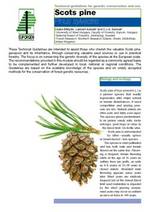Pinus sylvestris - Technical guidelines for genetic conservation and use for Scots pine
This publication has been translated into the following languages:
Slovenian
Conservation priorities
Because Scots pine is a species with an extremely wide distribution and occupying a broad range of habitats, genetic conservation seems to be a task of low priority. However, the need to address genetic resources of Scots pine is supported by the widely proven genetic diversity between populations, the effects of century-long cultivation and the expected environmental changes at the margins of the distribution.
As Scots pine is one of Europe’s most important tree species under forest management, the anthropogenic influence is obvious. Both survey and recording of native local (autochthonous) stands are important for gene conservation. These records could include various identification data; molecular markers become increasingly useful for this task.
Long-term provenance tests have proved the value and importance of locally adapted populations. This is valid primarily for extreme site conditions (higher altitudes, coastal environments, extreme boreal conditions, rocky or semiarid sites). Preserved populations on these sites exhibit less plasticity when transferred to other conditions, but are usually superior locally. Special care should be taken, therefore, to select representative populations for conservation on such sites. Native stands selected for gene conservation will also serve as ‘population standards’ when compared with man-made forests.
As with populations on extreme sites, isolated outliers might have been exposed to specific selection pressures or drift and may carry rare alleles. Such populations should be carefully protected and steps taken to collect forest reproduction material at the sites. Local material should be used for regeneration and material from endangered sites should also be established in ex situ conservation stands.
Expected climate change will first affect the populations at the southern fringes of the distributional range. These populations are often remarkably vigorous and tolerant and may be of value for future breeding. Here also ex situ measures should be applied to safeguard long-term survival.
The long tradition of artificial regeneration may have developed landraces that could also be targets for gene conservation efforts. These populations usually represent diverse, rather plastic genetic resources, valuable for future breeding and reproduction.
Establishment and management of gene conservation units
When selecting gene conservation units along a continuous cline, ecological information should be preferred to neutral markers. In the absence of drift, in a contiguous distribution range adaptively different populations may be expected at distances where annual mean temperature differs by a minimum of 1.0–1.5°C (equal to ca. 200 km in a flat landscape).
The size of gene conservation units of Scots pine should be sufficiently large to compensate for and buffer against outside geneflow: 100 ha should be considered the minimum. Nearby occurrences of genetically degraded or otherwise unsuitable stands should be either avoided or removed. A conservation unit should consist of numerous adjoining stands of various age, provided their origin is the same. In areas of scattered occurrence, initial size may be 10 ha as a minimum, which can be increased during successive regenerations.
In many instances the pioneer character of Scots pine demands human interaction to prevent ecological succession. As far as possible, natural regeneration should be applied; this is less problematic on drier or poorer sites. Regeneration of admixed species should be tolerated for ecological reasons. The light demand of the species does not allow the development of a very complex stand structure, but this is not necessary as evenaged stands may hold equal diversity. Regeneration felling should be carried out stepwise, allowing for recruitment from numerous seed years. Scots pine is genetically rather insensitive to the type of regeneration cutting used. However, if the influx of outside pollen were minimized (a goal which can be met with only partial success), shelterwood cutting would be preferred to other regeneration regimes. Fencing of the unit has to be considered where high game density threatens natural regeneration processes.
In certain cases artificial regeneration may be necessary (e.g. for ex situ conservation). To sample genetic resources properly, cones from 50 or more well-distributed trees should be collected (preferably in a good seed year). The quantity of seed from each tree must be equal in order to get a balanced participation in the final seed lot. Mixing of repeated seed harvests is beneficial, and no seed sorting or grading must be applied.
Direct sowing should be preferred to planting. If possible, planting should be carried out with higher density than usual to allow for more natural selection.
Intermediate low-intensity fellings and management should maintain a relatively dense stand structure. Selective removal of trees should be confined to malformed individuals; otherwise a broad variation of phenotypes should be allowed.
In summary, priorities for specific gene conservation measures will differ regionally. Preservation of genetic resources of Scots pine should be visualized in the context of locally applied forest management practices (especially control of seed sources for artificial regeneration), the extent of protected or unmanaged areas and the occurrence, density or fragmentation of the species at the landscape level, together with actual threats and risks. The urgency to set up gene conservation units will be much higher in an area with fragmented remnants of local populations surrounded by planted forests of uncontrolled origin than in a region where sustainable forestry relying on natural regeneration and local seed sources is practised.
Authors: Csaba Mátyás; Lennart Ackzell; Sam C.J.A. Samuel
Journal/Series: EUFORGEN Technical Guidelines for Genetic Conservation and Use
Publication Year: 2003
Publication Format: Folder; PDF
ISBN: 92-9043-661-1
ISBN 13: 978-92-9043-661-4
Language: EN
Pages: 6 p.

